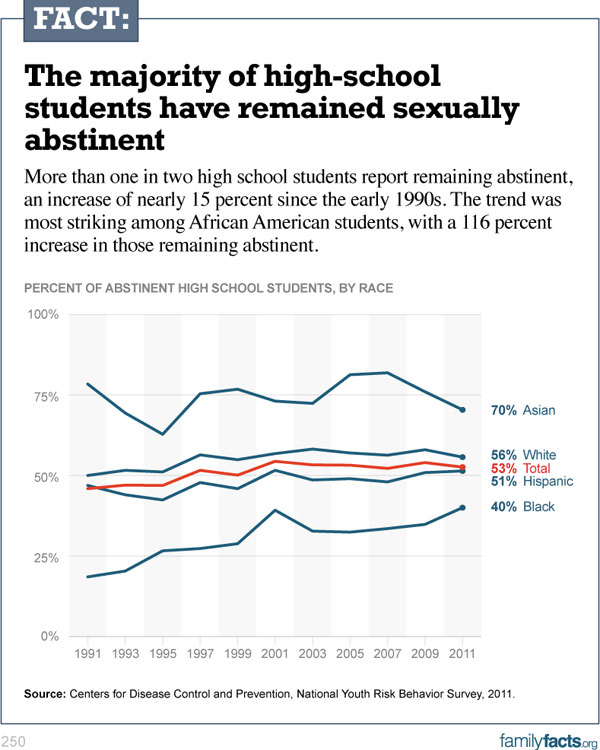Family Fact of Week: The Abstinent Majority
Christine Kim /
The abstinent minority has now become the majority.
Over the last two decades, teens have become more likely to remain sexually abstinent. According to the 2011 National Youth Risk Behavior Survey, 53 percent of high school students have remained abstinent, an increase of 15 percent, and two in three are currently abstinent.
According to a new, definitive two-part report from the National Abstinence Education Association (NAEA), “The Sexual Risk Avoidance (SRA) approach, sometimes called the Abstinence-centered approach, is effective, supported by parents, and is a message more and more teens are adopting in their own lives.”
SRA education is consistent with other public health risk-avoidance models, such as the anti-smoking, anti-drinking, anti-drug, and anti-violence campaigns that have been successful in changing both behavior and culture.
Largely misrepresented, SRA education is more than just about saying “no.” Abstinence-centered and holistic, the SRA strategy offers skill-building topics such as goal setting and future orientation, healthy decision making, building assets, avoiding negative peer pressure, and human development.
By contrast, the sexual risk reduction (SRR) model, often known as the “comprehensive” approach, “is built on the premise that teens either cannot, or will not, abstain from sex; therefore they must learn to take ‘precautions’ that will decrease their risk of becoming pregnant.”
As the NAEA report notes, this approach is narrow in focus, ignores any meaningful priority on risk avoidance, has been shown to contain medically inaccurate information, normalizes teen sex, undermines the role of parents, and lacks proven effectiveness in the classroom. Furthermore, a systematic review of “effective” SRR programs reveals a number of weaknesses in the research and casts doubt on the broad effectiveness claims made on their behalf.
Polls also show that both teens and parents strongly support the abstinence message. The NAEA report cites a 2010 national study that indicates that “70 percent of parents surveyed are opposed to pre-marital sex both in general and for their adolescents.”
Moreover, the majority of teens themselves are supportive of the abstinence message. Specifically:
- 62 percent of teens say that it is against their values to have sex before marriage;
- 75 percent of teens believe that having sex would make life difficult;
- 84 percent of teens oppose sex at their age; and
- 69 percent of teens oppose sex while in high school.
Moreover, social scientific research suggests that SRA education is associated with positive behavioral change among teens. The NAEA report details 25 peer-reviewed studies that have “demonstrated significant and positive behavioral change among student participants.”
Despite the research and parental and teen support for SRA approaches, the Obama Administration has nearly eliminated all federal funding of SRA education; instead, it has created additional programs for contraceptive-centered education, according to the NAEA report, while nearly eliminating support for risk avoidance. In the President’s fiscal year 2013 budget, the funding disparity between SRR and SRA is $37 million to $894.24 million, or 11 to 24.
When it comes to sex education, the debate is ostensibly fought on the grounds of empirical evidence, but it is ultimately one of values.

